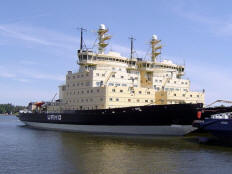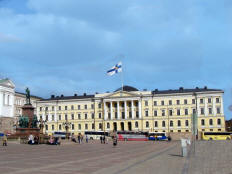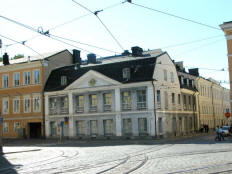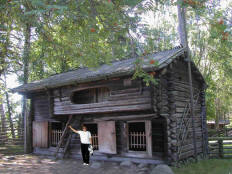Part I - Page 1 2 3 4 5 6 7 Go to: Part II Part III Part IV
HELSINKI
Friday, 19 August. The ship arrived in Helsinki, Finland, at 9:00, and our Helsinki Highlights & History tour left at 9:45. It was another lovely day. We drove through the city, by the Russian Embassy, then past a long ship terminal filled mostly with huge ferries. Apparently there is a tremendous amount of ferry traffic between Helsinki and Tallinn, Estonia. Also, Helsinki is the icebreaker capital of the world, and there were several of the vessels in the harbor. We passed the Market Hall, then Market Square, a block-long outdoor market where tourist goods have largely displaced the traditional fruits and vegetables. The City Hall and the Presidential Palace were directly across the street from the market, and the ornate Orthodox Upensky Cathedral (1868) sat on a small hill at the far end.
The bus took us a couple blocks up from the harbor for a stop at Senate Square, dominated by the white Lutheran Cathedral (1852) looming over it. This square was specifically designed as the center of the new city of Helsinki after Czar Alexander II of Russia annexed what is now Finland in 1809 and made it an autonomous Grand Duchy with Helsinki as its capital. Until then, the whole area had been a bunch of Swedish provinces, and Helsinki a small town. The Palace of the Council of State (1822) fills the east side of the Square and the University of Helsinki (1832) the west side. The Sederholm House, the city’s oldest stone building (1757), is also on the Square.
Back on the bus, we drove by the National Theater, the Central Station (1914), Mannerheim Square, the Contemporary Art Museum (1998), Parliament House (1931), and finally stopped at the Rock Church (Temppeliaukio). The church was built in granite bedrock (1969), and it looks like the upper part was built of pieces of granite blasted from the site.
From there, we were taken to the Seurasaari Open Air Museum located on a beautiful green island a few kilometers from the heart of Helsinki. Founded in 1909, it has 87 separate buildings, mostly from the18th to the 20th century, from all areas of Finland. A wooden church from Karuna is the oldest building (1686). We had refreshments served by costumed waitress in a restored building.
Heading back into the city, we passed the Olympic Stadium (1952), the new Opera House (1993), and Finlandia Hall (1971) before stopping at the Sibelius Monument (1967). The design of this memorial to composer Jean Sibelius, hundred of stainless steel pipes forming a tree, can only be described as controversial. We got back to the ship about 1:15 and had a light lunch. I then caught the shuttle back into the city center to take photos of some of the buildings we’d passed on the bus and to go through the stands in Market Square. There were many unique items for sale, including reindeer hides (very popular with the Japanese tourists) and various souvenirs made from reindeer antlers. When I finally returned to the shuttle stop, I was surprised to find a long line of at least 100 people. Even with standing passengers crammed in the aisle like sardines, it took seven buses (about 35 minutes) before I could get on. It was 4:45 by the time I got back on the ship. The ship sailed at 6:00 as we sat down for dinner. Afterward we went to the 9:00 show before retiring. We set our clocks ahead for the last time.
Part I - Page 1 2 3 4 5 6 7 Go to: Part II Part III Part IV |






















